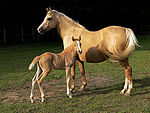- Anglo-Norman horse
-
Anglo-Norman horse 
An Anglo-Norman horse; illustration from the Brockhaus and Efron Encyclopedic Dictionary (1890—1906)Country of origin France Status extinct Horse (Equus ferus caballus) The Anglo-Norman horse was a warmblood horse breed from the old province of Normandy in northern France. From early in the 19th century, local Norman mares were crossed with imported English thoroughbreds, Norfolk Roadsters and half-breds, which themselves had Norfolk Roadster and Mecklenburg blood.[1] Three principal lines developed: a light draught horse, which became the Norman Cob of today; a fast harness-horse which was the origin of the present-day French trotter; and a general riding horse suitable for military use, the Anglo-Norman.[2] In 1958 the Anglo-Norman was fused with other regional warmblood saddle-horses such as the Angevin, the Charentais, the Charolais, the Cheval Limousin and the Vendéen in order to create the national warmblood stud-book, the Selle Francais or French saddle horse.
Prominent Anglo-Norman horses of the past include Nonius Senior, founding sire of the Nonius breed, Condor, Furioso II, Almé Z, and Cor de la Bryere.
The Anglo-Norman horse excelled in jumping. Winners included Lutteur B, an Olympic gold medal winner at Tokyo in 1964.[4]
Influence on other breeds
The Anglo-Norman was used to create several other breeds of horses throughout Europe and Asia. These included the Greek Andravida, which was created by crossing native Greek mares with Anglo-Norman stallions,[5] and the Swiss Freiberger, a blend of Anglo-Norman lines with Thoroughbreds and native horses from the Jura Mountains.[6] The Hungarian Nonius breed stems from an Anglo-Norman stallion named Nonius Senior,[7] and Anglo-Norman blood was also used to add refinement to the German Oldenburg.[8] In Asia, the Anglo-Norman was used to create the Chinese Heihe breed.[9]
See also
References
- ^ Gallier, Alfred (1900) Le cheval Anglo-Normand: avec photogravures intercalées dans le texte Paris: Baillière p.155
- ^ Edwards, Elwyn Hartley (1994) The Encyclopedia of the Horse London: Dorling Kindersley ISBN 0751301159 p.130
- ^ von Nathusius, Simon, Thomas von Nathusius, (1904) Die Pferderassen: Atlas der Rassen und Formen unserer Haustiere Stuttgart: Eugen Ulmer. (in German) "Horse breeds: atlas of the races and forms of our domestic animals"
- ^ Hayes FRCVS, Horace M., Points of the Horse, Stanley Paul, London, 1969
- ^ Hendricks, p. 170
- ^ Hendricks, p. 190
- ^ Hendricks, p. 312
- ^ Hendricks, pp. 323-324
- ^ Hendricks, pp. 214-215
- Hendricks, Bonnie (2007). International Encyclopedia of Horse Breeds. University of Oklahoma Press. ISBN 9780806138848.
Horse breeds of France These are the horse breeds considered in France to be wholly or partly of French origin.
Many have complex or obscure histories, so inclusion here does not necessarily imply that a breed is predominantly or exclusively French.Ardennais · AQPS · Auvergne horse · Auxois · Barraquand horse (also known as Vercors horse) · Boulonnais (Mareyeur, Cauchoix, Trait Picard, Bourbourien, Petit Boulonnais) · Breton (Trait, Postier, Cheval de Corlay, Centre-montagne) · Camargue horse · Castillonnais · Comtois · Corse horse · French Anglo-Arab · French Saddle Pony · French Trotter · Henson · Landais · Mérens · Nivernais · Norman Cob · Percheron · Poitevin · Pottok · Selle Français · Trait du NordExtinct breeds†Angevin · †Anglo-Normand · †Augeron · †Berrichon · †Bidets · †Bourbonnais · †Bourguignon · †Carrossier Normand · †Charentais · †Charolais · †Demi-sang du Centre · †Dombes horse (see also Bresse horse and Demi-sang de l'Ain) · †Limousin horse · †Loire horse · †Morvan horse · †Navarrin horse · †Saône-et-Loire · †Tarbésan · †Trait du Maine · †VendéenEquine Equine science and
management
Equestrianism
and sportGlossary of equestrian terms · List of Equestrian Sports · Horse tack · Bit · Bridle · Saddle · Harness · English riding · Western riding · Driving · Horse training · Horse racing · Equestrian at the Summer Olympics (medalists, venues) · Horse show · EquitationEvolution and history Domestication · In warfare · In the Middle Ages · Horses in East Asian warfare · History of the horse in South Asia · Horses in the Napoleonic Wars · Horses in World War I · Horses in World War II · History of the horse in BritainHorse breeds, types
and other EquidaeList of horse breeds · Wild horse · Feral horse · Stock horse · Gaited horse · Draft horse · Warmblood · Sport horse · List of horse breeds in DAD-ISOther EquusHybrids
This horse-related article is a stub. You can help Wikipedia by expanding it.

